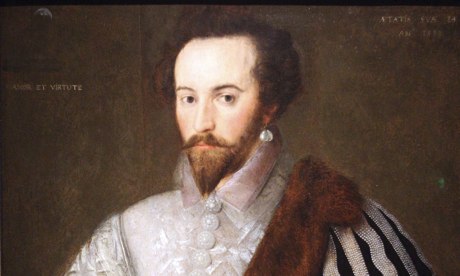Moon above waves in corner of portrait – symbolising queen's power over courtier – was painted out centuries ago


The portrait of Sir Walter Raleigh with the newly discovered crescent moon just visible in the top left corner. Click for full picture. Photograph: Lewis Whyld/PA
A piece of grovelling flattery by Sir Walter Raleigh to Good Queen Bess has been revealed again, centuries after it was painted out of his portrait. The restored painting is one of the stars of the new exhibition at the National Portrait Gallery, Elizabeth I & Her People.
The sailor frequently needed to ladle on the praise, since his years as a courtier were spent both in and out of favour and in prison in the Tower of London. In 1588 his star was riding high, a hero of the battles against the Spanish armada, and his magnificent cloak, covered in a dazzling sun-ray of pearls, would already have been understood as an emblem of the Virgin Queen.
But there was more. Newly exposed in the corner – curator Tarnya Cooper believes painted out in the 18th century when it was discoloured and merely baffling – is a crescent moon over an expanse of blue foam-flecked waves: Elizabeth the moon goddess ruling the tides and the life of her storm-tossed sailor. The pun would have been better in his West Country accent, Cooper says, when "Walter" and "water" would have been almost indistinguishable.
The portrait, by an unknown artist, now hangs beside a draft in his handwriting of a poem addressed to Cynthia – ie Elizabeth – in which he prostrates himself on the earth beneath her feet, describing himself as "an unblessed and ill borne creature that did me brace the dust her boddy baringe".
Only three years later he needed all the charm he could muster when he secretly married one of her ladies-in-waiting, Bess Throckmorton. The monarch clapped both of them in the Tower, and though they were freed, neither ever regained her full favour.
Raleigh's luck finally ran out in 1618 when he was executed, under a sentence passed 15 years earlier for conspiring against James I – his real crime the failure to return from his final expedition with the promised ships laden with gold.
His portrait now hangs among a mob of Elizabethans, aristocrats and the commoners who were just beginning to have their portraits made. They include a magnificently named butcher, Gamalier Pye, twice convicted of fraud; a female calligrapher; a brewer; a soldier complaining that he had been insufficiently rewarded who had himself painted with weapons and armour stuffed into every corner of the canvas; explorers and court beauties. A striking life-sized statue commemorates a handsome young Italian banker and spy who died in London of the plague – though inevitably some said he was murdered – and whose memorial survived the great fire only to lose its hands and feet in the blitz.
There are also many portraits of Tudor children, almost all understandably anxious looking: few lived into adulthood, and little John Dunch, whose piercingly blue mournful eyes stare straight at the viewer, never reached his second birthday.
Sandy Nairne, director of the NPG, said the exhibition was "a tremendous occasion" for the gallery, discussed for years not just by him but by his predecessors as they tried to assemble the public and private loans of rare and fragile works of art. The loans range from precious jewels and miniatures to some touchingly banal objects which are far rarer survivors, including a collection of Tudor dress pins, and a unique pair of battered and patched sailor's canvas breeches.
No comments:
Post a Comment